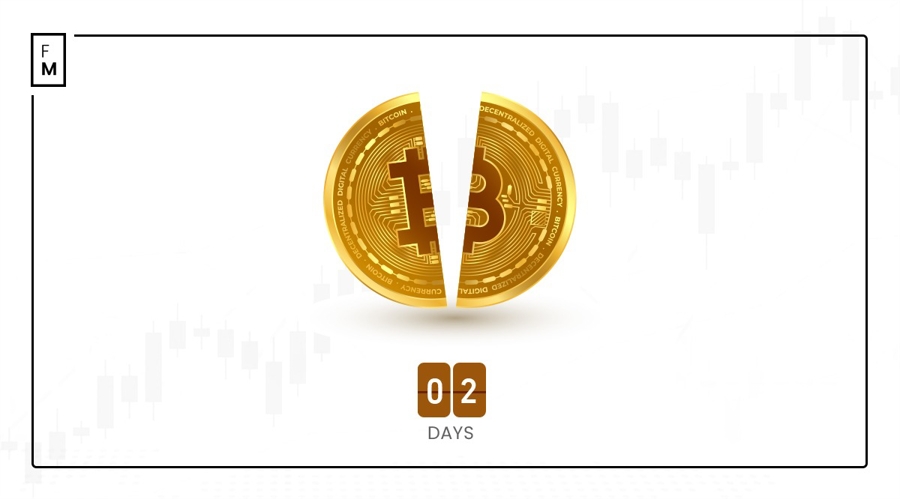Bitcoin Halving Countdown: Why Price Soaring Is Not Guaranteed
Bitcoin halving is an important event written into the cryptocurrency code, which is about to happen in two days。This event occurs approximately every four years and will halve the reward for Bitcoin miners.

Understanding Bitcoin Halving
With retail investors gaining access to bitcoin investments through ETFs, the halving is expected to have an impact on the entire financial system by 2024. This could lead to an increase in cryptocurrency trading, volume, investment and speculation in the sector, Finance Magnates reported. The Bitcoin halving event is set to happen in the next two days, according to the Coin Countdown.
A halving usually results in a significant decrease in income for miners. Additionally, the reduction in selling pressure may help increase trading volume and price Volatility in the market. Goldman Sachs recently warned investors not to associate the halving of Bitcoin with a price spike, according to Coindes k. This is because the continued rise in price relies on strong inflows into spot ETFs, not just halving.
While previous halves have been followed by price increases, Goldman Sachs noted that various macroeconomic factors play an important role. The firm emphasized that the time it takes to reach a peak has varied widely in the past. In addition, the macroeconomic environment during past halving periods differed from the current situation, which is characterized by high inflation and high interest rates.
Bitcoin ETFs and Market Dynamics
Similarly, Goldman Sachs emphasized in a Bloomberg report the importance of considering other factors, such as the adoption of spot ETFs, in driving bitcoin prices. Bitcoin prices have risen recently, driven by inflows into U.S. spot ETFs, suggesting that a significant portion of the halved expectations may already be priced in.
Echoing Goldman Sachs, Fred Thiel, chief executive officer of Marathon Digital Holdings Inc. said the successful approval of ETFs has accelerated the price appreciation that typically occurs after a halving. However, Thiel acknowledged that halving about Bitcoin's supply dynamics and emphasized miners' optimism about the event.
Bitcoin Cash
Bitcoin Cash (BCH) recently experienced its own halving. The cryptocurrency, which is a fork of Bitcoin, fell 15 percent after the event. According to Coindesk, this prompted cryptocurrency traders to reassess their expectations of an immediate price spike after Bitcoin's halving.
Bitcoin Cash was created in 2017 and has historically been seen as a gauge of sentiment in the bitcoin market. Its recent rally, as well as its sharp decline following the halving, suggests caution about Bitcoin's impending halving.
The decline in the price of Bitcoin Cash has been accompanied by a plunge in open positions in BCH futures. This trend suggests a change in market dynamics. Additionally, negative funding rates on major exchanges are reportedly highlighting a potential weakening of bullish sentiment.
Analyst and expert insights
Investment banking giant JP Morgan expects shares to fall to $42,000 once the halving hype dies down. The impending 50 percent reduction in miners' rewards could lead to increased selling pressure, which could impact the price trajectory of Bitcoin in the coming months.
Meanwhile, the Grayscale Spot Bitcoin ETF (GBTC) has recently seen a significant drop in its position. As of April 16, 2024, the fund's trading volume has halved to 309,871 BTC from when it first traded in January, according to Cointelegraph.
Since its inception, GBTC has faced a massive sell-off that has had a significant impact on the price of Bitcoin. Contributing to the outflow were high transaction fees, with GBTC initially having the highest fees of any U.S. spot bitcoin ETF at 1.5 percent. This difference in fees prompted other ETFs to lower their fees by between 0.2% and 0.4%.
In contrast, BlackRock's IBIT offered a competitive 0.25% fee at launch. As a result, IBIT has experienced a remarkable surge, increasing its position by more than 10,000% since its launch. Despite the lack of direct correlation, the surge in bitcoin has exacerbated significant events related to bitcoin.
Bitcoin ETF Landscape
Overall, as of April 16, 2024, total holdings in the ten U.S.-approved spot Bitcoin ETFs amounted to approximately 862,162 BTC, valued at $54.7 billion. While GBTC's decline and IBIT's spike have dominated the headlines, other ETF providers have amassed large bitcoin holdings, contributing to the dynamic landscape of bitcoin investing.
Meanwhile, bitcoin mining profitability has plummeted by 75% over the past three years. Profitability declined from March 2021 to March 2024, according to Stocklytics.com.
This trend is attributed to a number of factors, including rising costs associated with mining operations and the impact of the halving event on miners' rewards. The metric used to measure the profitability of Bitcoin mining is the hash price, expressed in dollars per terrahash (USD/TH). The metric is affected by a variety of factors, including the price of bitcoin, transaction fees, network complexity and block subsidies.
Despite past spikes in bitcoin prices, mining profitability has been steadily declining, with diminishing returns becoming increasingly apparent. The bitcoin mining business faces numerous challenges that affect profitability. Energy consumption is a significant issue, with the process consuming large amounts of electricity each year.
Disclaimer: The views in this article are from the original Creator and do not represent the views or position of Hawk Insight. The content of the article is for reference, communication and learning only, and does not constitute investment advice. If it involves copyright issues, please contact us for deletion.